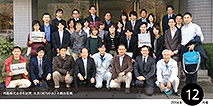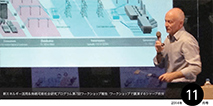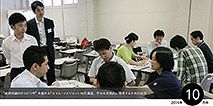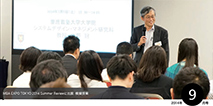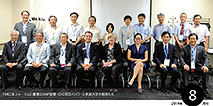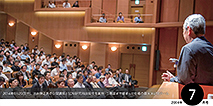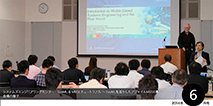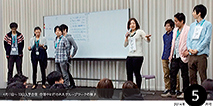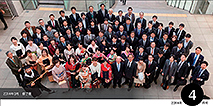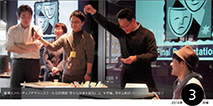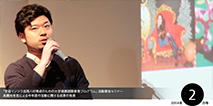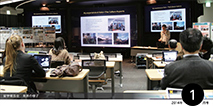SDM NEWS
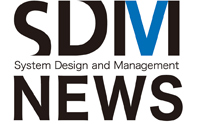 The monthly SDM Newsletter provides updates on educational and research activities in the Graduate School of System Design and Management and the SDM Research Institute to their supporters. Back issues are available for download from this page.
The monthly SDM Newsletter provides updates on educational and research activities in the Graduate School of System Design and Management and the SDM Research Institute to their supporters. Back issues are available for download from this page.
If you would like to subscribe to the SDM Newsletter by email, please write to us using the following Contact Form.
SDM Newsletters in Japanese are also available here.
 Message from the Faculty
Message from the FacultySystems Engineering for a High-tech Society
(Shinichiro Haruyama, Professor, Graduate School of System Design and Management)
One can feel that winter is around the corner as the year comes to an end and the beautiful yellow leaves of ginkgo boulevard trees begin to fall.
One of the new projects that Keio SDM launched in 2014 is the publication of translated versions of Engineering Systems Series (MIT Press). Keio SDM faculty led the translation, while Keio University Press Inc. published the texts. The first text was published in February 2014 and titled Engineering Systems: Meeting Human Needs in a Complex Technological World (Olivier L. de Weck, Daniel Roos and Christopher L. Magee; translated by Shinichiro Haruyama (Editor), Naohiko Kohtake, Seiko Shirasaka and Junko Tomita). The second text was published in October 2014 and titled Design Structure Matrix (DSM): Visualization and Management of Complex Systems (Steven D. Eppinger and Tyson R. Browning; translated by Hidekazu Nishimura (Editor), Koichi Ohtomi and Kenichi Seki). The concept of this series is the idea that it is extremely important to see the whole picture when studying, analyzing, exploring, proposing and designing technological and social systems such as that of communications, transportation and power supply, all of which have become increasingly complex in recent years. System and systems, which entails interactions of many systems, is difficult to design due to the boundaries of each system often not being clear. It is also extremely difficult to build or optimize an entire system. A high level of specialized knowledge about each technology type and of society is crucial in high-tech societies. The bigger the focus is on trees (specialized knowledge), the more difficult it becomes to see the forest (the entire system). Today, Japan and the rest of the world find themselves in exactly this situation.
In order to halt the status quo, Keio SDM is nurturing human resources who can see the forest through its publications, courses and research activities. We continue our educational research by placing particular importance on the design and verification of architecture that keeps the entire system in view, on design thinking that generates innovative ideas and on the management required for executing these aspects.
In order to halt the status quo, Keio SDM is nurturing human resources who can see the forest through its publications, courses and research activities. We continue our educational research by placing particular importance on the design and verification of architecture that keeps the entire system in view, on design thinking that generates innovative ideas and on the management required for executing these aspects.
- TOPICS
-
1. Keio SDM Extension Lecture: "Positive Workshop for Nurturing Happiness"2. The Customary OPEN KiDS (third session in 2014)3. "Management of the Future: People-Centered Management and Leadership"4. Visit to Nishijima CorporationLaboratory Profile: The Laboratory for International Politico-Economic Systems
 Message from the Faculty
Message from the FacultyThoughts on the Western "Vision"
(Hidekazu Nishimura, Professor, Graduate School of System Design and Management)
OMG Japan held the Industrial Internet Symposium on Wednesday, October 29, 2014. At the symposium, information was exchanged on the Industrial Internet Consortium (hereafter referred to as "IIC") of the US and the Industry 4.0 of Germany.
The IIC and Industry 4.0 have indicated their future direction, in that they plan to accelerate the utilization of Internet of Things (IoT) in the manufacturing, supply chains, health care, energy, and transportation industries, thereby aspiring for a significant transformation by 2030.
When you read documents related to these topics, you will notice that all of them are based upon systems engineering and that Model-based Systems Engineering (MBSE) is required because the systems that they target are extremely complex and large scale. At the INCOSE International Symposium 2014 held in July, a vision toward 2025 titled "INCOSE SE Vision 2025" was presented. This document is also available for those who are not INCOSE members and I strongly recommend you read it, as it clearly lays out their plan of developing new systems with a technological approach in order to maximize values for systems of systems in which the natural environment, communities, and economies interrelate with systems that they target. The role that systems engineering should play in realizing such a vision is going to be considerably significant. It will play a role of informing policymakers of the need to introduce new systems. According to the lectures given at the above-mentioned symposium, a large-scale Dutch company which makes semiconductor manufacturing devices has already begun its preparation to move in the direction indicated by the Industry 4.0. It is going to be extremely important for so-called "product lifecycle management" to be integrated with upstream system development. In doing so, the existence of a "model" consistent with the substance of products will be crucial. My task would be to make sure that we will not be left behind the Western vision, as such.
When you read documents related to these topics, you will notice that all of them are based upon systems engineering and that Model-based Systems Engineering (MBSE) is required because the systems that they target are extremely complex and large scale. At the INCOSE International Symposium 2014 held in July, a vision toward 2025 titled "INCOSE SE Vision 2025" was presented. This document is also available for those who are not INCOSE members and I strongly recommend you read it, as it clearly lays out their plan of developing new systems with a technological approach in order to maximize values for systems of systems in which the natural environment, communities, and economies interrelate with systems that they target. The role that systems engineering should play in realizing such a vision is going to be considerably significant. It will play a role of informing policymakers of the need to introduce new systems. According to the lectures given at the above-mentioned symposium, a large-scale Dutch company which makes semiconductor manufacturing devices has already begun its preparation to move in the direction indicated by the Industry 4.0. It is going to be extremely important for so-called "product lifecycle management" to be integrated with upstream system development. In doing so, the existence of a "model" consistent with the substance of products will be crucial. My task would be to make sure that we will not be left behind the Western vision, as such.
- TOPICS
-
1. The Second Open KiDS: "Design Workshop for Innovation Generation"2. Social Design and Innovation in Regions3. Keio SDM Extension Lecture: "Think Japan's Social Design with an Eye Toward 2020"4. Reports on the Seventh Workshop for the New Energy Utilization and Sustainable Society Research Program5. Keio SDM Holds Ideathon: G Space Future Design Project6. The First Half of the Project Design Camp7. NE Academy: Introduction to Model-based Systems EngineeringColumn: With an Eye toward an Easy Optical Transmission of Super High Resolution VideoEnergy Management in Low Carbon SocietyLaboratory Profile: Sports Design Management Laboratory
 Message from the Faculty
Message from the FacultyIs prevailing orthodoxy true?
(Masaru Nakano, Professor, Graduate School of System Design and Management)
Qualitative theory which overturns the prevailing orthodoxy is receiving attention particularly in the study of business administration.
The common belief that swans are white was reversed when black swans were discovered in Australia. Based on such history, a book was published entitled, Finding a Black Swan in Management: A Guide Book of Case Study. Prevailing orthodoxy is also not always true when it comes to economic and social systems. For example, the prevailing orthodoxy that a weaker yen will promote exports of Japanese manufacturing companies and will eventually improve the Japanese economy is coming under scrutiny nowadays. We may need to rethink the prevailing negative views on higher tax rates, stronger currency, higher salary levels, higher interests and fewer working hours, while re-visiting our positive views on local production and a merit system. It seems that Denmark and Finland are advancing thanks to their solid social security system backed by high tax rates, while Switzerland's economy continues to grow by securing knowledgeable, skilled human resources backed by high salary levels as its currency has stayed strong. According to the World Economic Outlook Database, GDP per capita of the above-mentioned countries was higher than that of Japan in 2013: Switzerland was 4th; Denmark was 6th and Finland was 14th, while Japan was 24th. Needless to say, whether or not higher GDP per capita reflects the level of happiness is subject to discussion. Nevertheless, it is probably difficult for Japan to secure young and excellent human resources who have international minds from global markets, given the oppressive working conditions and low salary levels.
At Keio SDM we are developing a management education program which integrates design games and business games (serious games). This year we have been organizing related classes and seminars for Keio students together with the Massachusetts Institute of Technology (MIT) and the Swiss Federal Institute of Technology (ETH). Many exchange students also attend the classes and seminars as they are conducted in English, creating a platform for international education. In the future, we plan to expand the educational program so that it can also cater to working professionals. In so doing, we plan to introduce idea generation which enables participants to learn to reverse common beliefs as mentioned above. We will also utilize serious games so that participants can learn while having fun in groups.
At Keio SDM we are developing a management education program which integrates design games and business games (serious games). This year we have been organizing related classes and seminars for Keio students together with the Massachusetts Institute of Technology (MIT) and the Swiss Federal Institute of Technology (ETH). Many exchange students also attend the classes and seminars as they are conducted in English, creating a platform for international education. In the future, we plan to expand the educational program so that it can also cater to working professionals. In so doing, we plan to introduce idea generation which enables participants to learn to reverse common beliefs as mentioned above. We will also utilize serious games so that participants can learn while having fun in groups.
- TOPICS
-
1. The Second Seminar on Agriculture, Rural Areas and Local Revitalization ends on a high note2. The Time Management Special Course to master the "8 skills to shorten delivery time"3. Japan-US Joint Team (in which Keio SDM students played a central role) wins first prize at the International Student Contest-Design for Human Exploration of Mars4. The Keio SDM Faculty Camp5. Information session for the Project Design Camp6. The AGRI (Agricultural) Laboratory visits Obuse Town in Nagano Prefecture7. The symposium for "Koto" Monozukuri ("creation of matters and things"):
Issues and Measures of Japanese Companies Concerning Innovation Generation8. The Lecture on "New Trends of Business Management"9. The Japan Creativity Society's award ceremony10. The Conversation Experiment Project for the Robot Astronaut "Kirobo" which Keio SDM helped developed receives the Good Design AwardColumn: The need for third-party institutions providing reassurance and safetyLocation Information Big DataLaboratory Profile: VSE Center (Japanese VSE Center)
 Message from the Faculty
Message from the FacultyDesign Abilities in Projects
(Tetsuya Toma, Associate Professor, Graduate School of System Design and Management)
Late summer greeting from Keio SDM! The nip of fall is in the air. I would like to take this opportunity to thank the supporters of our educational and research activities.
I teach Project Management at Keio SDM. In fact, only a few Japanese universities offer project management as a required subject. In today's diverse society, which is rapidly changing, various things interrelate with each other in a complex manner. Had Yukichi Fukuzawa been alive, he would no doubt be teaching project management, for I believe that it is a practical subject that is very much needed by society. With new technologies emerging in the world today, it is increasingly difficult to predict markets because people change their minds. To obtain a view of the entire picture of various situations surrounding a project and to actually draw things the way they should be is like a design process: expressing details by adding colors to a drawing on a large canvas. By doing this we can work concretely however complex the project is, and we begin to clearly see the goals, objectives and procedures for different tasks. Design sensibility is essential not only at the planning stage but also at the implementation phase. Designing is a process of making decisions without losing sight of the big picture while organizing the available information and balancing different effects in ever-changing situations. This is where Keio SDM's "system x design thinking" comes in. The SDM Research Institute affiliated with Keio SDM holds open seminars. As part of the seminars I am coordinating the Project Design Camp, which will be held in November and December. The camp will use a distinguished educational style and aims to put Keio SDM's capacity development method into practice. Through training opportunities like this, I hope to contribute to the nurturing of future project managers who are going to change society for the next generation.
- TOPICS
-
1. Workshop:"Experiencing SDM Workshop Designed by Students
(Seeing and Hearing is not Sufficient. Let's Experience SDM Workshop!)"2. Extension Lecture by Ms. Akiko Suzuki, "System Design and Management for Late-Blooming Power: Detour Generates Power"3. Extension Lecture by Ms. Miyako Tanaka-Oulevey,"The Skills to Deal with Stress Introduced by Top Athletes-Coping Skills Enable to Live a Positive Life-"4. Reports on International Symposium by INCOSE5. The Extension Lecture by Mr. Takeshi Uchiyamada and Keio SDM Information Session6. Participation in MBA EXPO TOKYO 2014 Summer Review7. Keio Systems School: "Introduction to System Thinking: Try Expressing All Objects and Things with Models"8. Best Paper Award at iDECON2014Column: New Advancement of Tele Immersion TechnologyModern History Offers a New Avenue for Tomorrow (SDM Lectures Transcripts)Laboratory Profile: The Universal Design Laboratory
 Message from the Faculty
Message from the FacultySDM is a stage for discovering new self
(Ryuichi Teshima, Professor, Graduate School of System Design and Management)
My name is Ryuichi Teshima. I teach Intelligence System Theory at Keio SDM. As I worked many years as a special correspondent for NHK (Japan Broadcasting Corporation), I feel strongly as to the importance of "mid-term careers." Japanese journalists tend to decline as they experience severe competition on the ground because they fail to replenish their intelligence; it is like slash and burn agriculture.
When I was Chief of NHK Washington DC Bureau I had many American colleagues who devoted themselves to their studies at graduate schools while working. Organizations tend to exploit their active mid-career professionals to the maximum possible extent, and once they are worn out they remove the old ones and replace them with young staff members, who are full of energy. This may be convenient for the company, but gives no justice to mid-career staff. Life is precious because we live only once: it is necessary to pose for the occasional replenishment of our intellectual capacity and take a step forward in a new direction. Although this is quite normal overseas, it is still rare for professionals to take a moment for intellectual replenishment during one's career in Japan. Keio SDM is a new type of graduate school that supports individuals towards overcoming their challenges in life. This graduate school is filled with students who have shared visions and are determined to change systems of Japanese society; to transform the way society ought to be in the regions and to establish companies by believing in their potential. In addition, we have many alumni who completed their studies at Keio SDM and are applying what they learned to actual cases in the society. Our monthly seminars are attended by just as many graduates as current students, where they would share their views on various issues. Seminars are open to those who are considering studying at Keio SDM. You are welcome to join us whenever you have the chance.
- TOPICS
-
1. The Best Paper Award at the PLM142. Keio SDM Co-Sponsors PMI Japan Forum from Sat, July 12 to Sunday, July 13, 20143. The Opening of Keio SDM Obuse Social Design CenterColumn: The Visible Light Communications Association commences its activities in May 2014Systems Modeling Language, SysMLLaboratory Profile: The Local Resource Utilization Laboratory
 Message from the Faculty
Message from the FacultyThe Power to Create a Future Filled with Hope
(Kenichi Takano, Professor, Graduate School of System Design and Management)
Looking at the recent trend of the world, I often feel that there is a big current shift in each of the social, political and economic spheres - in particular since the Great East Japan Earthquake.
In the social sphere, regarding the need to address the falling birth rate and aging population (the population decrease) a consensus is being built gradually and concrete measures are beginning to be taken. Concerning international politics, the cold war ended and the U.S. is not the superpower it once was. This has completely changed the political landscape for Japan as well. With regard to the internal affairs of Japan, as the liberal parties have declined, the conservatives have come back into the picture. As the economy is moving out of a period of deflation, the big old companies are rapidly losing their power, while smaller companies with distinct business models and superior qualities are emerging. In this situation, the 2020 Olympic Games offer a beacon of hope. There is no doubt that the key to Japan's bright future is "innovation" in various social, political and economic spheres. Innovation has been flourishing in both the public and the private sector. However, I am not entirely sure that innovation, by which I mean entrepreneurial spirit and risk-taking attitude for unknown businesses, can really take root in Japan. I had a chance to discuss this with young entrepreneurs and venture capitalists the other day. Among the various topics that we discussed, what struck me was that the group of young entrepreneurs was concentrated in an area of 500 square meters around Dogenzaka, Shibuya - it was as if their businesses were an extension of the university's extra-curricular activities. In this area, a safety net for business failures and a reputation system are functioning, while a number of students are establishing their own companies after interning there. Keio SDM is beginning to function as a society, as such. I was happy to think that the innovations of the latter half of the 21st century would be generated by young minds such as these.
- TOPICS
-
1. Reports on the International Symposium: CESUN 20142. Mr. Nobuyuki Idei's Extension Lecture and SDM Information Session on Friday, June 20, 20143. Health Social Big Data Project4. KPRI Demonstrates Research Findings at the Yagami Campus Tour Organized for the 75-year anniversary of the Faculty of Science & Technology of Keio University5. Location Business Japan (LBJ) 2014Column: Report on the OMG Technical Meeting in Boston: Thoughts after participating for the first timeSystems Approach for Business EngineeringLaboratory Profile: Social Design Center (SDC)
 Message from the Faculty
Message from the FacultyFrom Systematizing Innovation Generation Activities to Concept Engineering
(Seiko Shirasaka, Associate Professor, Graduate School of System Design and Management)
In the 2013 academic year, we attempted to systematize activities for innovation generation based on system x design thinking, which Keio SDM has been researching and educating. Special focus was placed on leveraging diversity in order to systematize workshop designs for the purpose of gaining collective wisdom.
Keio SDM has been commissioned by the Ministry of Education, Culture, Sports, Science and Technology (MEXT) to implement "Development of Dialogue Tools for Innovations" as part of the COI Stream Seeds Needs Project. In collaboration with thirty different universities and research institutes, we have developed a methodology for the ways in which different methods can be best combined to generate innovative ideas by building on the wisdom and knowledge accumulated by Keio SDM. More specifically, a methodology for "innovative thinking", i.e., to think more consciously than ever about what you have never considered before ("thinking outside the box"), has been established. However, it is rare that innovations are generated solely through workshops. Rather, it is more common to presume that innovations are generated when workshops are combined with a range of other activities. We will therefore continue our endeavors for systemization, while broadening our theme of covering innovation generation activities through a new project commissioned by MEXT, "The Project of High-level Coordination Human Resource Development for Innovations." Through this project, teaching materials will be produced for the purpose of nurturing human resources capable of high-level coordination. In addition, we plan to establish "concept engineering", or engineering for concept development, in an effort to further incorporate systems engineering in our activities this academic year. By combining these new activities and approaches, we are able to present yet another year of excitement at Keio SDM.
- TOPICS
-
1. Keio SDM Professor Tomohiko Taniguchi's Lecture at the Keio SDM Information Session2. "Introduction to Collaborative Creation with System x Design Thinking (Introductory Workshop)"3. The Systems Engineering Center: SysML & MBSE Tutorial - Introduction to Agile MBSE Utilizing SysML4. The Future Session: "The Future of Sports Careers in Japan 2020" on Sunday, June 8Engineering Systems: Meeting Human Needs in a Complex Technological WorldLaboratory Profile: Mobility Systems Management Center
 Message from the Faculty
Message from the FacultyFrom Keio SDM to Tokyo 2020
(Naohiko Kohtake, Associate Professor, Graduate School of System Design and Management)
It was decided at IOC's 123rd General Meeting in September 2013 at Buenos Aires that the 2020 Olympics and Paralympics would be held in Tokyo. It will have been 56 years since a summer Olympics was last held in Japan, and it will have been 22 years since the Nagano Olympics.
One of the features of Keio SDM is that not only the faculty members, but also many of its students, have viable ties with, or are active members of, the business community. In fact, the faculty and students of Keio SDM were greatly involved in the efforts of hosting the upcoming Olympics and Paralympics. On the day that Tokyo was selected as the next host in Buenos Aires, photos of Keio SDM's faculty and students were broadcasted to those waiting at home and the excitement was shared among all members. The occasion gives us hope, including the children of the next generation, because Japan also faces various issues, such as the rebuilding of the areas destroyed by the 2011 disaster, the falling birth rate and the aging population, and economic recovery. The fact that the festivities that the entire world focuses on will be held in Tokyo in 2020 gives Japan a great opportunity to regain its energy and strength for the future. The SDM Research Institute established the Sports Design Management Laboratory in 2013 after one year of preparation, with the aim of improving the technical effectiveness of sports and nurturing human resources, as well as improving the value and understanding of sports through collaboration with various non-sports sectors. In addition, in the present year - 2014 - it has been six years since the foundation of Keio SDM, while we have six more years until the Tokyo Olympics and Paralympics. Certainly, Keio SDM should play a significant role in making the Tokyo Olympics and Paralympics a success, and also in addressing the social problems of Japan and the world after 2020, the timing for 'a leap'. I believe we can make valuable and significant contributions to society if students, researchers, faculty and staff work on various projects as one. For this, Keio SDM endeavors to nurture future international leaders through research and education based on systems approach.
- TOPICS
-
1. Keio SDM's Information Session on April 192. Introductory Camp: April 11-133. Symposium on Big Data Innovation on March 174. Keio SDM's Interaction Session on April 195. Signing of Cooperation Agreements with MIT and University of CopenhagenChange the World with System x Design Thinking - "How to Innovate" by Keio SDMLaboratory Profile: AGRI (Agricultural Laboratory)
 Message from the Faculty
Message from the FacultyGreetings on the Occasion of Joining SDM
(Tomohiko Taniguchi, Professor, Graduate School of System Design and Management)
Since the day I made my first cry in Takamatsu, Kagawa, I have moved 25 times, worked at seven different places and have changed jobs six times. I am now 56 and have 33 years of work experience. If I exclude the 20 years that I worked for "Nikkei Business", I changed jobs every five years and on average moved every 2.2 years.
My approach to life has always been that I will not rely on organizations and have been in too much of a hurry. Though I have been self-indulgent, wanting only to do what I enjoyed and felt passionate about, I somehow always expected and believed in a kind-of pre-established harmony. I constantly tried new things and in this way found myself in an amazing port and dropped anchor as the proverb states: "The dog that trots about finds a bone." And now here I am, at Keio SDM.
There is a saying: "Once a journalist, always a journalist." This is probably true for me, as I believe that what I have been doing all this time is showing others the different ways in which events can be interpreted, by analyzing events in an historical context on the vertical axis and according to geopolitics on the horizontal axis. Now that I have been given a chance to join a faculty consisting of progressive spirits, I will continue my pursuits in this manner. No economic phenomenon is independent of politics and power is never free from economic interests. In principle, systems cannot be interpreted without analyzing the history behind them, including the judgment as to whether they are rational or irrational. At Keio SDM, I will strive to move freely between these two seemingly different approaches and hope that my students will share this experience with me.
Management consists of leadership and followership. If management is a technique with which to provide positive incentives to a large number of people, it is essential that leaders who want to be exceptional and followers who want to generate and implement excellent incentive structures have the intellectual reflexes that will allow them to move freely between two or more things. It is my aim to do the best I can to help nurture such reflexes. In addition to my role at Keio SDM, I will be working on a series of ad-hoc special assignments for Prime Minister Abe. My talents, if you will, are the following two things: I can cut out sleeping and my motivation age does not increase contrary to my physical age. I will do the best I can while relying on these strengths that are, frankly, not worth boasting about.
There is a saying: "Once a journalist, always a journalist." This is probably true for me, as I believe that what I have been doing all this time is showing others the different ways in which events can be interpreted, by analyzing events in an historical context on the vertical axis and according to geopolitics on the horizontal axis. Now that I have been given a chance to join a faculty consisting of progressive spirits, I will continue my pursuits in this manner. No economic phenomenon is independent of politics and power is never free from economic interests. In principle, systems cannot be interpreted without analyzing the history behind them, including the judgment as to whether they are rational or irrational. At Keio SDM, I will strive to move freely between these two seemingly different approaches and hope that my students will share this experience with me.
Management consists of leadership and followership. If management is a technique with which to provide positive incentives to a large number of people, it is essential that leaders who want to be exceptional and followers who want to generate and implement excellent incentive structures have the intellectual reflexes that will allow them to move freely between two or more things. It is my aim to do the best I can to help nurture such reflexes. In addition to my role at Keio SDM, I will be working on a series of ad-hoc special assignments for Prime Minister Abe. My talents, if you will, are the following two things: I can cut out sleeping and my motivation age does not increase contrary to my physical age. I will do the best I can while relying on these strengths that are, frankly, not worth boasting about.
 Aiming at the Same Goal as Keio SDM
Aiming at the Same Goal as Keio SDM(Makoto Ioki, Associate Professor, Graduate School of System Design and Management)
My name is Makoto Ioki. I joined Keio SDM as a faculty member in April 2014. I worked on space systems for 27 years at a private firm. There, I was directly involved in the entire life cycle of satellite systems, from the conceptual phase to the detailed design, manufacturing, testing and finally operation following launching.
I have been working toward realizing systemic monozukuri ("the art, science and craft of making things") by utilizing methods of systems engineering, a main discipline at Keio SDM. I was also involved in educational activities for the public. I explained how Japan's space system was being utilized in everyday life. I also took part in field studies with the aim of introducing Japanese satellites and satellite utilization technologies to other countries, acting as a bridge builder between Japan and these countries to promote the utilization of Japanese technologies. Through these works, I have been exploring how to promote Japan's space industry.
Building on my experience in space systems, I will be pursuing a means of abstracting this knowledge, thereby linking it to new methods and ways of thinking that are independent of established sectors and fields. I also want to research how the validity and appropriateness of such an approach should be evaluated. Specifically, I am keen to discover the process - how a concept evolves from the initial stage of its lifecycle to a final output - by applying a range of existing research methods.
Systems engineering has been established as a method by inductively analyzing findings from a number of different cases. In order to apply this particular method to actual cases, a deductive approach is needed; thus, it is necessary to keep in mind the organic mutual relationship between induction and deduction. Additionally, in order to "see the forest for the trees", one needs to be able to move freely between concrete thinking and abstraction, while keeping multiple perspectives in mind. I believe the key to linking theory to reality is not only about distinguishing opposite concepts from one another, but also by embracing the whole. It is therefore that I apply myself with renewed determination toward Keio SDM's goal - finding solutions to society's problems from within a broad range of perspectives, on spatial and semantic scales, as well as on time scale.
Building on my experience in space systems, I will be pursuing a means of abstracting this knowledge, thereby linking it to new methods and ways of thinking that are independent of established sectors and fields. I also want to research how the validity and appropriateness of such an approach should be evaluated. Specifically, I am keen to discover the process - how a concept evolves from the initial stage of its lifecycle to a final output - by applying a range of existing research methods.
Systems engineering has been established as a method by inductively analyzing findings from a number of different cases. In order to apply this particular method to actual cases, a deductive approach is needed; thus, it is necessary to keep in mind the organic mutual relationship between induction and deduction. Additionally, in order to "see the forest for the trees", one needs to be able to move freely between concrete thinking and abstraction, while keeping multiple perspectives in mind. I believe the key to linking theory to reality is not only about distinguishing opposite concepts from one another, but also by embracing the whole. It is therefore that I apply myself with renewed determination toward Keio SDM's goal - finding solutions to society's problems from within a broad range of perspectives, on spatial and semantic scales, as well as on time scale.
- TOPICS
-
1. Commencement of the Academic Year 2013/14 for March Graduates2. The Second Annual Conference of the Innovation Education Academic Society3. PMP® Exam Preparation Course Offered in March and April4. Workshop: "The Sixth New Energy Utilization and Sustainable Society Research Program"5. Signing of Cooperation Agreements with MIT and University of Copenhagen6. "The First Seminar on Agriculture, Rural Area and Local Revitalization"7. Nakatani, Visiting Researcher, Reveals the "Function of Skin Sensor for Soft Touch"Laboratory Profile: Lab profiles do not appear in this issue.
 Message from the Faculty
Message from the FacultyThoughts Prior to Leaving Keio SDM
(Shoichi Sasaki, Professor, Graduate School of System Design and Management)
I joined Keio SDM when it was founded in April 2008 and am finishing my term this March. During the six years that I have been with Keio SDM, I taught courses on systems engineering, dependable systems, electronic system safety and others while supervising Master students' research.
Prior to joining Keio SDM, I was employed as an engineer at an automobile company. Thus, I was completely new to being an academic faculty member. However, I imagined that my professional experience in human resource development and project management would be relevant to my educational activities at Keio SDM, as they were significant aspects of my work along with the technical development. I was right about this in some instances, but wrong in others. Contrary to my expectations, Keio SDM covered themes much wider in scope than I had imagined, i.e., that of society.
At first, I was not entirely sure whether the methods of systems engineering could be applied to social designs. However, eventually I came to understand the importance of incorporating social systems through teaching. In other words, I realized that systems engineering has limitations, because it only targets technical systems. As I changed my work from being an engineer at an automobile company to a faculty member at a university, I began to understand the important role of a university within a society: to help indicate in what way society and its technologies should be developed and to provide the means for achieving this. I greatly enjoyed the intellectual excitement at Keio SDM; many pioneering activities are carried out here. The six years I spent at Keio SDM went by in the blink of an eye. I will continue my research and remain close to Keio SDM. Please do not be a stranger and say hi when you see me around!
At first, I was not entirely sure whether the methods of systems engineering could be applied to social designs. However, eventually I came to understand the importance of incorporating social systems through teaching. In other words, I realized that systems engineering has limitations, because it only targets technical systems. As I changed my work from being an engineer at an automobile company to a faculty member at a university, I began to understand the important role of a university within a society: to help indicate in what way society and its technologies should be developed and to provide the means for achieving this. I greatly enjoyed the intellectual excitement at Keio SDM; many pioneering activities are carried out here. The six years I spent at Keio SDM went by in the blink of an eye. I will continue my research and remain close to Keio SDM. Please do not be a stranger and say hi when you see me around!
 (Ken Victor Leonard Hijino, Associate Professor, Graduate School of System Design and Management)
(Ken Victor Leonard Hijino, Associate Professor, Graduate School of System Design and Management)This will be my last article in the SDM newsletter as I will be leaving Keio to begin a new job from April 1st , 2014. I would like to thank all of those in SDM as well as its supporters who have made my three years experience there very rich and rewarding. Looking back, I think I have really learned as much as I have taught at SDM.
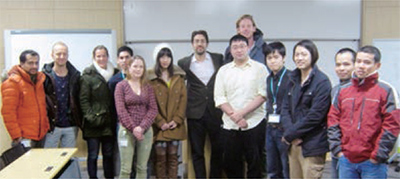 When I first heard of Keio SDM, I had only a dim idea of how the concepts of systems, design, and management came together. All that I knew, after my first guest lecture (something about Julian Assange and Wikileaks in 2010), was that this was a very ambitious and innovative graduate school with a gorgeous campus and a fascinating mixture of mature, professional, and young students. That first impression remains with me to this day.
When I first heard of Keio SDM, I had only a dim idea of how the concepts of systems, design, and management came together. All that I knew, after my first guest lecture (something about Julian Assange and Wikileaks in 2010), was that this was a very ambitious and innovative graduate school with a gorgeous campus and a fascinating mixture of mature, professional, and young students. That first impression remains with me to this day.Before coming here, I never imagined I would be giving academic advice on research about systems involving automotive supply-chains, satellite signals, happiness and personal breakthroughs, traditional Tohoku dance, fruit and vegetable display designs. All of these are some of the few master's dissertations I had the pleasure of listening to and assessing. Those back to back 10-hour days (from 9 in the morning to 7 at night) of listening to presentations by master and doctor students were one of the most physically exhausting experiences at Keio SDM. But looking back, it was also a very rewarding opportunity to hear cutting edge research presentations from all sorts of domains.
I also learned much from giving social science methods and political science classes to students who did not necessarily have prior background in these disciplines. Teaching these courses forced me to distil key concepts and data most important and useful for a lay audience. The feedback and questions about politics from mature students of various professional backgrounds in my classes was very stimulating as well.
Although I will be focusing more closely on my own specialty, both in teaching and research, in Kansai, I hope to bring with me many of the valuable lessons learned at SDM. I look forward to watching and contributing to SDMs future success as it soars to new heights of innovation in research and education. Good luck SDM!
- TOPICS
-
1. Keio Innovative Design School Extension Lecture: "What Does It Take To Create a Happy Society"2. Keio SDM & TU Delft TPM's Collaborative Extension Lecture: "Metropolis Revolution - From European Viewpoints" on Tuesday, February 25, 20143. Final Lecture by Professor Shoichi Sasaki4. New Publication: Change the World with System x Design Thinking - "How to Innovate" by Keio SDM5. The Agriculture Laboratory in a New Book, Let's Become Happy with Agriculture in Rural TownsLaboratory Profile: Smart System Design Laboratory
 Message from the Faculty
Message from the FacultyThe Olympics and System Design
(Tetsuro Ogi, Professor, Graduate School of System Design and Management)
I am writing this article as the Sochi Olympics begin. When I watch the Olympic Games live on TV, I tend to look for the various new technologies and systems that are behind the stage while I cheer for Japanese athletes.
For speed skating, for example, a new system has been introduced to display world-record lines. For bobsledding, a system is used to display real-time data sent from the speed sensor. Video feeds from wearable cameras show what athletes see, making the competition even more appealing to the audience.
In fact, a number of large-scale and complex systems operate during the Olympics, such as video systems relaying the opening ceremony, results systems transmitting real-time game results on TV and the internet, information delivery systems for smart phones and ticket sales management systems. These systems operate for only a few weeks during the Olympics. Nevertheless, no error or failure is tolerated, as the entire world is watching. The reliability of the systems is, therefore, an extremely critical issue. In order for the Olympics to be successful, there are other systems, besides information systems, that are equally critical, such as facilities and infrastructures supporting the transportation as well as accommodation and guidance for the audience.
When the Tokyo Olympics were held in 1964, a number of new technologies and systems were introduced: transportation infrastructures like shinkansen ("bullet trains") and highways, televisions for homes and newly-developed real-time computer systems. Although it is not widely known, the pictograms which are commonly used for toilet signs today were first introduced to guide foreigners at the time of the Tokyo Olympics. It has been decided that Tokyo will host the 2020 Olympics. As part of the preparations, different systems of new technologies are being explored, including cloud computing, 8K imaging and augmented reality (AR). While I hope to see the development of athletes for the upcoming Tokyo Olympics, I also look forward to the development of various Omotenashi ("spirit of Japanese hospitality") systems that are particular to Japan.
In fact, a number of large-scale and complex systems operate during the Olympics, such as video systems relaying the opening ceremony, results systems transmitting real-time game results on TV and the internet, information delivery systems for smart phones and ticket sales management systems. These systems operate for only a few weeks during the Olympics. Nevertheless, no error or failure is tolerated, as the entire world is watching. The reliability of the systems is, therefore, an extremely critical issue. In order for the Olympics to be successful, there are other systems, besides information systems, that are equally critical, such as facilities and infrastructures supporting the transportation as well as accommodation and guidance for the audience.
When the Tokyo Olympics were held in 1964, a number of new technologies and systems were introduced: transportation infrastructures like shinkansen ("bullet trains") and highways, televisions for homes and newly-developed real-time computer systems. Although it is not widely known, the pictograms which are commonly used for toilet signs today were first introduced to guide foreigners at the time of the Tokyo Olympics. It has been decided that Tokyo will host the 2020 Olympics. As part of the preparations, different systems of new technologies are being explored, including cloud computing, 8K imaging and augmented reality (AR). While I hope to see the development of athletes for the upcoming Tokyo Olympics, I also look forward to the development of various Omotenashi ("spirit of Japanese hospitality") systems that are particular to Japan.
- TOPICS
-
1. Heated Dialogue: "Public Philosophy x System Design and Management--Design Peace for the 21st Century"2. Symposium to Commemorate the Publication of the Japanese Version of Engineering Systems3. Seminar to Report on "the Inter-University International Education Program: Human Resource Development for the Utilization of Space Infrastructure"Laboratory Profile: Model-Driven System Development Laboratory
 Message from the Dean of Keio SDM and the Research Institute
Message from the Dean of Keio SDM and the Research InstituteFirst Year of Management
(Takashi Maeno, Director, SDM Research Institute Dean, Graduate School of System Design and Management)
Happy New Year! 2014 is going to be a year of "management" for Keio SDM. 2012 was a year of "design", in which we focused on the Design Project and the Keio Innovative Design School ("KiDS"), while 2013 was a "system" year in which we focused on systems engineering and system thinking alongside Keio Systems School commencing its activities. This year, we will focus on SDM's third keyword, "management."
What do I mean by focusing on management?
One aim is to focus on education and research related to management. We have been carrying out educational and research activities concerning management in a number of ways and on topics like project management, organizational management, system management and management of innovative new projects. I would like to see these initiatives strengthened this academic year. As part of such an attempt, we would like to bolster the activities of the Management Design Center even further. We can do this by implementing different variations for the Project Management Training that we have been conducting, as well as by hosting symposiums. We hope to contribute to various fields that involve projects.
Another aim is to strengthen management of Keio SDM itself. We have been collaborating with one another to manage Keio SDM by capitalizing on the strengths of each faculty, students and staff, and we would like to further enhance our cooperation and collaborative creation this year. In other words, it is about creating synergy, not only by furthering the strengths of each person, but also by combining each person's strength. It is how we manage "the future design of Keio SDM as a system." While making the foundation of SDM stronger, each member can pursue the world's leading education and research-I would like to see such kind of thing in the year of management. More specifically, we will endeavor to revitalize joint research among faculty members, to strengthen collaboration between classes by improving mutual understanding of main classes and to enhance cooperation for management activities. Your continued cooperation and guidance would therefore be greatly appreciated.
One aim is to focus on education and research related to management. We have been carrying out educational and research activities concerning management in a number of ways and on topics like project management, organizational management, system management and management of innovative new projects. I would like to see these initiatives strengthened this academic year. As part of such an attempt, we would like to bolster the activities of the Management Design Center even further. We can do this by implementing different variations for the Project Management Training that we have been conducting, as well as by hosting symposiums. We hope to contribute to various fields that involve projects.
Another aim is to strengthen management of Keio SDM itself. We have been collaborating with one another to manage Keio SDM by capitalizing on the strengths of each faculty, students and staff, and we would like to further enhance our cooperation and collaborative creation this year. In other words, it is about creating synergy, not only by furthering the strengths of each person, but also by combining each person's strength. It is how we manage "the future design of Keio SDM as a system." While making the foundation of SDM stronger, each member can pursue the world's leading education and research-I would like to see such kind of thing in the year of management. More specifically, we will endeavor to revitalize joint research among faculty members, to strengthen collaboration between classes by improving mutual understanding of main classes and to enhance cooperation for management activities. Your continued cooperation and guidance would therefore be greatly appreciated.
- TOPICS
-
1. Keio SDM's Fifth Anniversary Event2. Open KiDS Special: "Workshop for Innovative Creation"3. Study Abroad Reporting SessionLaboratory Profile: Space System Laboratory

